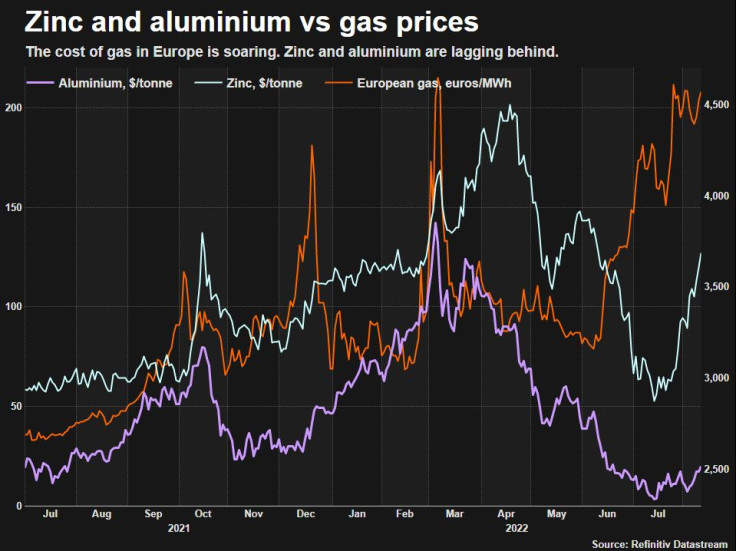Sky-high Energy Costs To Fan Fire Under Aluminium And Zinc Prices
Slowing economic growth is weighing on industrial metals prices but zinc and aluminium are likely to outperform if sky-high energy prices force European smelters to cut output further, leading to larger shortages.
Prices of metals including copper, aluminium and zinc have tumbled between 20% and 50% from record highs in March as interest rate rises tilt the world towards recession and weaker metals demand.
But the price of energy used by smelters has shot up, particularly in Europe, which has less Russian gas and oil since Russia invaded Ukraine, and further price rises are expected in winter.
Smelting aluminium, used in the transport, packaging and construction industries, and zinc, used to galvanise steel, require large amounts of electricity.
Between August 2021, when energy prices first began to rocket, and peaks in early March, aluminium prices rose by 60% and zinc by 65%.
Glencore, the biggest zinc producer in Europe, recently said high power prices made production "very challenging". Glencore produced 350,900 tonnes of zinc in Europe in the first half of this year.
Energy now accounts for around 80% of the cost of producing aluminium and zinc in Europe, up from historical averages of 40% for aluminium and 50% for zinc, analysts at Macquarie said.
"Aluminium looks the best to us in terms of the fundamentals," said Macquarie analyst Marcus Garvey.
Smelter closures in Europe could cut aluminium capacity by 750,000 tonnes and zinc output by 150,000 tonnes this winter, on top of cuts of around 800,000 tonnes for aluminium and 138,000 tonnes for zinc since energy prices began to surge in 2021, Garvey said.
Extra cuts could worsen deficits that Macquarie estimates are around 800,000 tonnes in the 70 million tonne aluminium market and 200,000 tonnes in the 14 million tonne zinc market this year.
"It's probably only a matter of time before zinc rallies again," said Sucden analyst Geordie Wilkes, pointing to a disconnect between falling metal prices and rising gas and power costs.
GRAPHIC: Zinc and aluminium vs gas prices (

)
Stockpiles of both metals are low, adding to supply fears.
Aluminium inventories in the London Metal Exchange (LME) warehouse system are below 300,000 tonnes from around 1.3 million tonnes a year ago.
LME zinc stocks have slid to around 75,000 tonnes from 240,000 tonnes a year ago - and more than one-third is already scheduled for delivery.
However, a sharp economic slowdown in Europe and the United States later this year could reduce demand for metals, potentially offsetting supply cuts and reducing their effect on prices, analysts said.
High energy prices - or even rationing of energy in Europe in winter - could also curtail demand.
"Metals-consuming manufacturers would likely also get swept into the curbs, generating a shock to demand that would likely either fully offset or even overwhelm closures to supply," said analysts at JPMorgan.
GRAPHIC: Falling inventories (

)
© Copyright Thomson Reuters 2024. All rights reserved.







